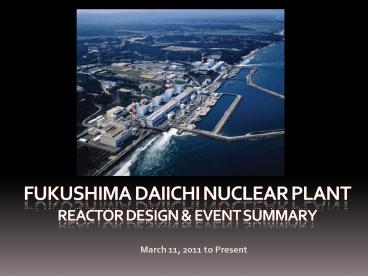Fukushima Daiichi Nuclear Plant Reactor Design PowerPoint PPT Presentation
1 / 22
Title: Fukushima Daiichi Nuclear Plant Reactor Design
1
Fukushima Daiichi Nuclear PlantReactor Design
Event Summary
- March 11, 2011 to Present
2
Presentation Overview
Kashiwazaki-Kariwa spent fuel pool during the
earthquake in 2007
3
Reactor Design GE Mark I BWR
Fuel Pool
Drywell Head
Reactor
Containment
Drywell
Suppression Pool
4
Reactor Building Elevation View and Under
Construction
5
Reactor and Control Rod Design
6
GE Mark I BWR Plant System Schematic
7
GE Mark I BWR Reactor System Schematic
8
GE Mark I BWR Fuel Pool
9
Reactor Cavity and Fuel Pool
10
Event Chronology - Initial Station Response
- Nuclear reactors were shutdown automatically.
Within seconds the control rods were inserted
into core and nuclear chain reaction stopped. - Cooling systems were placed in operation to
remove the residual heat. The residual heat load
is about 3 of the heat load under normal
operating conditions. - Earthquake resulted in the loss of offsite power
which is the normal supply to plant. - Emergency Diesel Generators started and powered
station emergency cooling systems. - One hour later, the station was struck by the
tsunami. The tsunami was larger than what the
plant was designed for. The tsunami took out all
multiple sets of the backup Emergency Diesel
generators. - Reactor operators were able to utilize emergency
battery power to provide power for cooling the
core for 8 hours. - Operators followed abnormal operating procedures
and emergency operating procedures.
11
Event Chronology Loss of Make-up Water
- Offsite power could not be restored and delays
occurred obtaining and connecting portable
generators. - After the batteries ran out, residual heat could
not be carried away. - Reactor temperatures increased and water levels
in the reactor decreased, eventually uncovering
and overheating the core. - Hydrogen was produced from metal-water reactions
in the reactor. - Operators vented the reactor to relieve steam
pressure - energy (and hydrogen) was released
into the primary containment (drywell) causing
primary containment temperatures and pressures to
increase. - Operators took actions to vent the primary
containment to control containment pressure and
hydrogen levels. Required to protect the primary
containment from failure. - Primary Containment Venting is through a filtered
path that travels through duct work in the
secondary containment to an elevated release
point on the refuel floor (on top of the reactor
building). - A hydrogen detonation subsequently occurred while
venting the secondary containment. Occurred
shortly after and aftershock at the station.
Spark likely ignited hydrogen.
12
Event Chronology Hydrogen Explosions
13
Event Chronology Core Damage Model
Core Uncovered
Fuel Overheating
Fuel melting - Core Damaged
Core Damaged but retained in vessel
Containment pressurizes. Leakage possible at
drywell head
Releases of hydrogen into secondary containment
Some portions of core melt into lower RPV head
14
Event Chronology Cooling Strategy
- The station was able to deploy portable
generators and utilize a portable pump to inject
sea water into the reactor and primary
containment. - Station was successful in flooding the primary
containment to cool the reactor vessel and debris
that may have been released into the primary
containment. - Boric acid was added to the seawater used for
injection. Boric acid is liquid control rod.
The boron captures neutrons and speeds up the
cooling down of the core. Boron also reduces the
release of iodine by buffering the containment
water pH.
Containment Flooding Effects
15
(No Transcript)
16
Current Station Status Report March 21
These are current reports from the website link
below which is to The Japan Atomic Industrial
Forum,Inc. (JAIF) It was incorporated as the
comprehensive non-governmental organization on
nuclear energy in Japan on March 1, 1956 (much
like WANO)
http//www.jaif.or.jp/english/
Status Report for March 21
Reactor Status Report for March 21
(To open documents, put cursor over document,
double click)
17
What does this mean to OPG and other Canadian
CANDUs?
The following letter was recently sent to OPG and
all other Canadian Power Reactors
(To open document, put cursor over document,
double click)
18
Station Photos of Damage
19
Station Photos of Damage
20
Station Photos of Damage
21
Station Photos of Damage
22
Station Photos of Damage

